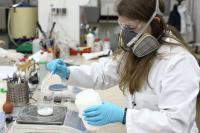Changing a Negative into Positive
An opponent runs up. He takes a swing and... he kicks our footballer in his shin as hard as he can. And how does the latter react? He does not feel a thing—that is how specialist pads currently being developed at Warsaw University of Technology are supposed to work.
The invention being developed by a team of scientists from Warsaw University of Technology is a material to produce shin-pads for football players. It is supposed to have specific qualities: on one hand it will be light and flexible, while on the other it will absorb the energy from the blow. ‘The pain should be experienced by the kicker and not the kicked’, Associate Professor Mikołaj Szafran, Project Manager, explains.
How is it possible? The secret lies in the properties of some liquids. Most of them have the same viscosity (or consistency) irrespective of how fast they are moving. However, there is a group of liquids in nature that have different viscosity depending on the speed of movement. If you stir them slowly, nothing happens. If you stir them fast, their viscosity increases quite rapidly, or—in short—the liquids immediately become thicker, some of them to such an extent that they resemble flexible solid objects rather than liquids. Such properties are displayed by ceramic powder suspensions. This was discovered a long time ago, but until now it has been treated as a hindrance.
Such liquids happened to become thicker while being transported by pipelines. A jam occurred as a result, pumps would burn and factories suffered losses. ‘Every negative aspect can be changed into a positive one’, Professor Szafran claims. And this is exactly what Warsaw scientists decided to do. They assumed that the properties of ceramic powder suspension which allows it to become thick quickly might be used to create protective materials. ‘If you soak a fabric with such a liquid and move your leg or arm normally, nothing will happen. But if you hit something suddenly with your fist or a knife, then the material’s viscosity will increase rapidly and it will behave like a solid object. The material will absorb the energy of the blow’, the Professor explains.
The first idea to use it is shin-pads for football players. The concept was simple, but there were a lot of challenges to be overcome: what kind of liquid and ceramic powder were supposed to be used to make the fabric as light as possible? How big should the powder grains be, and how much do you need to make the liquid become firm only with a specifically hard blow? How to prevent the substance from getting less sticky in higher temperatures? And the most difficult issue—how to prevent the liquid from dripping down the fabric? All these problems have already been solved by scientists from the Warsaw University of Technology. At the moment they only have laboratory quantities of protective fabrics, and it all works just fine. ‘Our tests prove that the fabric absorbs as much as 70% of the energy of the blow. If you kick the shin pad with the force of 10 kg, only 3 kg will be felt. The other 7 kg will be absorbed by the fabric’, Professor Szafran claims.
The prototype of the shin-pads is being produced at a scientific and industrial consortium. Now the researchers are working on how to improve the material. In a few months the results of their test will be sent to Polsport, a sports equipment producer. The company will produce the first pattern of shin-pads. And what will happen later? Perhaps they will go into regular production. The scientists are already thinking about other products, such as elbow pads, helmets or vests. However, each of the new applications require new tests and a change of composition. ‘We normally move our leg with a different speed than our arm. We therefore need materials whose viscosity changes at a different moment’, the Project Manager explains. However, as the scientists assure us, introducing modifications is not a problem. What is most important is that their innovations work.
Description of the project comes from the catalogue of the National Research and Development Centre "Innovation for Development".







